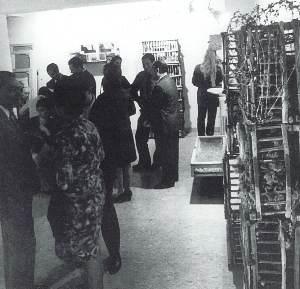You know, for a couple of weeks now, I've had this thing Bomb Magazine tumbld sitting in my browser, some teaser for their archive about Richard Serra dangling a chicken in Rauschenberg's face at Yale, which, of course, he did, in 1966.
Here's the actual quote from David Seidner's 1993 BOMB interview with Serra:
DS Here's another question you're not going to like. Can you define early Serra and late Serra?1966, when Rauschenberg was a full decade beyond his own Chicken Period, but when his taxidermied Combines were getting their first sustained public attention in museums.RS If you talk about the pieces that were done in '66, that's early work. If you talk about the work I'm doing now, I wouldn't call it "late work." But I would call it work that's certainly more developed.
DS Speaking of the early work, is it true that at Yale you put a live chicken in front of Rauschenberg's face?
RS No, I actually tied it to a dowel, which was anchored into a block and the chicken was in a box. And when Rauschenberg opened the box, the chicken flew up in the air about fifteen feet, and then stopped, because it was tethered. It began to flap its wings, it crowed and shit. (laughter) They kicked me out for two weeks. They told me I wasn't "polite to guests." How can they kick you out of art school?
What I hadn't noticed, because I'd stopped at the chicken, and then had been stopped by a tall image of Stacked Steel Slabs, is the next part, where Serra discusses what might be called his High Chicken Period. Oh wait, that's right, Time Magazine already dubbed it his "Zoo Period":
DS Why did you give up painting?Dada, again, was the charge/context leveled early on at both Rauschenberg and Johns. Buchloh had brushed off Serra's first solo1 show, at the influential Galeria la Salita in Rome as "rather literal responses to Rauschenberg's combines," yet here is another example, from 1993, pre-Torqued Ellipse revival, of Serra discussing this early show as a "bridge" from painting to sculpture and his early work in direct relation/response to both Rauschenberg and Johns. [Johns' studio, of course, was also the site of Serra's first thrown lead corner piece.]RS I was using paint with a certain disdain, with the attitude that any material was as good as any other material. And once you find that you're not using paint for its illusionistic capabilities or its color refraction but as a material that happens to be "red," you can use any material as equally relevant. I started using a host load of materials. I was living in Fiesole outside of Florence at the time and I started using everything that was in the parameters of my surroundings: sticks and stones and hides. I did a whole show of 22 live and stuffed animals.
DS Cages.
RS Well, cages and habitats. I got very fascinated with the history of zoos. The first zoos were in Florence and the Florentines saw zoos not only scientifically but as aesthetic displays.
DS That was the bridge for you between painting and sculpture?
RS Yes, that was the bridge, I referred to Jasper John's beer can (Is it real, is it painted?). At one stage, I had a double cage with a live chicken and a stuffed rabbit. I showed the work in Rome and all the Italian artists came and screamed, "ignoble, brute."
DS The Arte Povera artists?
RS Arte Povera hadn't started at that time, a year and a half later Arte Povera began and they were all too willing to line horses up in a basement but up to that point they looked at my work as not being legitimate, it wasn't even Dada.
I think the power [or assertions] of Serra's subsequent achievements overwhelm this first, early body of work. But Serra repeatedly brings it up and has now[once, at least] connected it to his move into sculpture. Whether it ends up being major, earth-shattering work, it is important to Serra's beginnings and should really be looked at more thoroughly.
1 Serra made the work in the show with his then-wife, fellow Yale classmate and sculptor Nancy Graves. The type of work, and now, Serra's mention of early Italian zoos, all have direct resonance with Graves's early animal/taxidermy/museum display work. Much of it will probably never be known now, but there is a lot more to the story of this show.
Just read the whole thing, it's pretty loopy, with some good comments on Richter, Polke, Tuttle, and Hesse: Richard Serra by David Seidner,
BOMB 42/Winter 1993 [bombsite]













